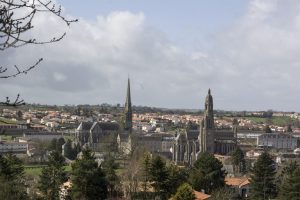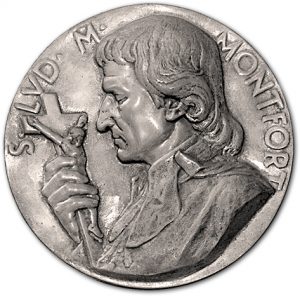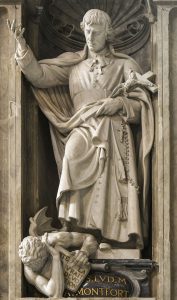As pure as an Angel, as zealous as an Apostle, as long-suffering as a penitent—he was a tireless missionary of the love of Jesus through Mary, and predicted a multitude of fiery souls who would come in future times.
It was the year 1716. The mission in Saint-Laurent-sur-Sèvre—which would be the last!—began in early April. Spent by work, the dedicated preacher had come down with acute pleurisy, but did not cancel the sermon promised for the afternoon of the visit of the Bishop of La Rochelle, Most Rev. Étienne de Champflour, on April 22. He spoke on the tenderness of Jesus, and was taken from the pulpit on the verge of death…
Some days later, foreseeing that he would die that year, he requested that when placed in the coffin, the chains that he wore around his neck, arms and feet as a symbol of his slavery of love to the Blessed Virgin Mary be left on his body. On April 27, the sick man dictated his will and bequeathed his missionary work to Father René Mulot.
The following morning, it was apparent that the final moment was nigh. In his right hand, he held a crucifix indulgenced by Pope Clement XI, and in the left, a small statue of Mary which always accompanied him. He kissed both, contemplating them with deep piety. In the afternoon, the dying man seemed to be waging his last battle against an invisible enemy: “You attack me in vain. I am between Jesus and Mary. Deo gratias et Mariæ. I have reached the end of my course: at last, I shall sin no more!” 1 As night fell, he surrendered his soul to God at only 43 years of age.
Thousands of people came to venerate the mortal remains of their apostle, and Bishop Champflour affirmed that he had lost “the best priest of the Diocese.” 2 Such was St. Louis Marie Grignion de Montfort, a “priest who lived with the purity of an Angel, worked with the zeal of an Apostle, and suffered with the rigour of a penitent.” 3
His Marian doctrine has spread far and wide. But his life—which despite its brevity was rich in fruits—is lesser known. Let us contemplate it briefly.

Chosen from childhood
He was born on January 31, 1673, in the Bretagne city of Montfort-La-Cane—today Montfort-sur-Meu—, into a family of 18 children. “The people of Brittany give themselves entirely; they are a breed of strong convictions,” 4 and Louis inherited this robust spirit. His parents, Jean-Baptiste Grignion and Jeanne Robert, brought him to the baptismal font the day after his birth, in the parish Church of Saint-Jean.
When he was still very young, the family settled on the property of Bois-Marquer, in Iffendic. The city’s old church received his first prayers and was the cradle of his ardent devotion to the Blessed Sacrament. There he made his First Communion and spent hours in recollection.
He revealed an apostolic spirit even as a child; he encouraged his mother in her domestic difficulties and helped his siblings, especially little Louise, who would one day, became a nun with the Benedictines of the Blessed Sacrament through his mentoring.
He became acquainted with the love of the Blessed Virgin in the heart of his mother, and this love became the Montfortian way par excellence. Actually, “the Blessed Virgin was the first to choose and elect him as one of her great favourites, and engraved in his young soul the outstanding affection which he always held for her.” 5
In the school of the Jesuits of Rennes
At age 12, his parents sent him to Rennes, to study at St. Thomas Becket College, directed by the Jesuits, renowned for their course in humanities and for forming their students with an authentic Christian spirit. The education was free and their over one thousand students were not boarders; accordingly Louis Marie lodged with his uncle, the Abbot Alain Robert de la Vizuele.
He was an excellent student and took tenaciously to his studies, convinced of their importance for the spiritual life and for the future ministry that he had in sight. With a recollected spirit, he withdrew from the agitation of the noisy throng of students, filling his leisure hours with visiting the churches of the city, where beautiful and captivating statues of the Virgin Mary were venerated. Undoubtedly, this affectionate and sincere devotion was the safeguard of his purity and a secure refuge against worldly allurements.
There he became acquainted with Jean-Baptiste Blain and Claude-François Poullart des Places, and forged a deep friendship with them. Later, they would provide valuable support for his foundations. He belonged to the school’s Marian Congregation and, with Poullart des Places, organized an association in honour of the Blessed Virgin, with the goal of increasing dedication to her, “stimulating his colleagues to greater fervour and making shine before the eyes of these young souls the beauties of the priesthood and the apostolate.” 6 After the death of the Saint, Blain wrote his personal recollections and memoirs, which became a key historic source on his life.
Louis Marie was very charitable, often acting as almsgiver in benefit of a classmate poorer than himself, which became a common practice during his missionary life. “He only spoke of God and the things of God; he only breathed zeal for the salvation of souls; and, unable to contain the flame of love for God that burned in his heart, he sought to alleviate it through effective examples of charity toward neighbour.” 7
Despite the heavy workload he took on, St. Louis found time to develop his artistic penchant: he was gifted at sculpting—particularly statues of Mary; he also painted and composed music and poems.
In Rennes, he felt the definitive call to the clerical state. One of his companions—to whom he confided this grace—tells us that it was at the feet of Our Lady of Peace, in the church of the Carmelites, that he became aware of his priestly vocation, “the sole way that God showed him, by means of the Virgin Mary.” 8
The seminary in Paris
In 1693, he set out for Paris to prepare for the priesthood. He left his native land and his family behind, and embarked on a trek of more than 300 km toward the French capital. This would invariably be his mode of travel, whether on pilgrimage or mission.
Even the Paris of the remote seventeenth century held fascinating allure for visitors. When he entered the city, the first sacrifice that Louis made was to mortify his curiosity: he made a pact with his eyes, denying them the licit pleasure of contemplating the incomparable works of Parisian art. When he left, ten years later, he had seen nothing that had satisfied the senses.

He began his studies in the seminary of Fr. Claude de la Barmondière, which had been established to receive needy youth. With the death of this religious, Montfort transferred to Montaigu College, directed by F. Boucher. The food there was scanty and his penances were so austere that his health was undermined and he had to be hospitalized. His state was so serious that it was thought he would die, but he never doubted that he would be cured, for he felt that his time had not come. And, in fact, he soon recovered.
Divine Providence found a way for him to finish his studies in the Little Seminary of Saint-Sulpice. The director of that institution, aware of the seminarian’s reputation for sanctity, “saw the entrance of this young cleric into his house as a great grace from God. To give thanks to God, he ordered the praying of the Te Deum.” 9 However, he treated Louis Marie with rigour, in order to put his virtue to the test. This opened for our Saint a path of humiliations, which he would tread his entire life.
Finally, a priest!
He fulfilled duties entrusted to him with all possible perfection, whether they were humble tasks, studies, the decoration of the church and seminary or fulfilling the role of liturgical master of ceremonies, at the service of the altar.
His first missions date back to this time. Some were given within the seminary, to increase the devotion of his confreres; others consisted in catechism classes or preaching, for people from outside. “He possessed a rare talent for touching hearts.” 10 He spoke to children of God, the goodness of Mary and the Sacraments which they needed to receive; he prompted adults to sanctify their labours by keeping their minds set on Heaven.
He made every effort to spread the practice of the slavery of love to Our Lady among his classmates, and he established an association for the slaves of Mary in the seminary. He had no shortage of opponents who charged him with exaggeration. He followed the advice of Fr. Louis Tronson, superior of Saint-Sulpice, in designating these devotees as “slaves of Jesus in Mary.” 11 This expression would later be immortalized in his Treatise of True Devotion to Mary.
“As priesthood loomed on the horizon, Louis Marie felt the growing need to separate himself from the world in order to completely recollect himself in God.” 12 He was ordained on June 5 of 1700, on the Feast of Pentecost, and chose to celebrate his first Mass in the chapel of the Blessed Virgin, behind the choir of the Church of Saint-Sulpice, which he had so often adorned during his seminary years. Blain, his friend and biographer, summed up his own impressions of that supernatural spectacle in five words: he was “an angel at the altar.” 13
From Nantes to Poitiers
The priestly spirit of Fr. Louis Marie experienced an insatiable thirst for souls, and the missions in faraway lands especially attracted him. He asked himself: “What are we doing here […] while there are so many souls that perish in Japan and India for want of preachers and catechists?” 14
But God had other immediate plans for his missionary. He was appointed to exercise his ministry in the Saint-Clement community of clerics in Nantes, at which annual retreats and Sunday conferences were preached for the clergy of the region. He went where obedience demanded, but his heart was divided between the desire for a hidden and recollected life and the call to the popular missions, which so attracted him.
A successful missionary experience in Grandchamps, on the outskirts of Nantes, was decisive in revealing his gifts as an evangelizer. Some time later, the Bishop of Poitiers convoked him to work in the hospital of that city, since his short stay there previously had left such a supernatural trail that the poor patients requested him as chaplain. It was also in this city that he met Catherine Brunet and Marie-Louise Trichet, with whom he would later found the Daughters of Wisdom in Saint-Laurent-sur-Sèvre.

Papal blessing: Missionary apostolic
The missionary activity of St. Louis Grignion eventually aroused envy, intrigue, and even persecution from those who should have defended him, obliging him to return to Paris. This set in motion a long series of sufferings that would accompany him through subsequent missions. The authenticity of his words and his example met with so many misinterpretations and calumnies that the missionary decided to make a pilgrimage on foot to Rome to seek enlightenment from the Pope regarding what course he should take in life. “Such difficulty in doing good in France and such opposition from all sides” 15 led him to consider if it might not be better to exercise his ministry in another country.
He was benevolently received by Clement XI, who encouraged him to continue exercising his missionary work in France. And to “confer more authority to him, he gave Fr. Montfort the title of Missionary apostolic.” 16 At the request of the Saint, the Pontiff granted a plenary indulgence to all who kissed his ivory crucifix at the hour of death, “pronouncing the names of Jesus and Mary with contrition for their sins.” 17
Strengthened by the papal blessing and with the crucifix mounted atop his staff that he took on his missions, Grignion returned to the lands of Gaul and with nothing to fear from persecutions or opposition. There, he intrepidly continued to sow, everywhere he went, the love of Eternal Wisdom and Our Lady, and the excellence of the holy Rosary. He converted entire populations, changed the licentious customs in the countryside, cities, and villages, erected Calvaries, restored chapels, and fought the spirit of Jansenism, so widespread at that time.
Nevertheless, he was little understood by many of his ecclesiastical contemporaries and withstood a wave of interdictions which were unleashed against him. Without losing heart, he continued his mission, and was welcomed by the Bishops of the Dioceses of Luçon and La Rochelle in the Vendée, a region that would react, at the close of that century, to the impiety spread by the French Revolution. This was undoubtedly a fruit of the harvest he had sown.
His sights fixed on the future…
However, it would be erroneous to consider St. Louis Grignion as nothing more than an excellent missionary of eighteenth century France. With his sights fixed on the future, his fiery soul aimed at extending the Reign of Christ, through Mary, making use of a form of evangelization that is entirely relevant today: “going from parish to parish, providing religious instruction to youngsters, converting sinners, preaching the love of Jesus, devotion to the Blessed Virgin and imploring, in a loud voice, a Company of missionaries who would shake the world with their apostolate.” 18
With prophetic élan, he foresaw the coming of missionaries who, through their entire surrender in the hands of the Virgin Mary, would satisfy the deepest yearnings of her Divine Son’s Heart: “God wishes that His holy Mother should be at present more known, more loved, more honoured than she has ever been.” 19 Nevertheless, he asked: “But who shall those servants, slaves and children of Mary be?” 20 And he affirmed that they would be “the true apostles of the latter times, to whom the Lord of Hosts shall give the word and the might to work marvels.” 21 He foresaw that they would be entirely enkindled with the fire of divine love: “priests who are free with the freedom that comes from Thee, detached from everything, without father, mother, brothers, sisters or relatives and friends as the world and the flesh understand them, without worldly possessions to encumber or distract them, and devoid of all self-interest.” 22
St. Louis Marie Grignion de Montfort was none other than the precursor of these apostles of the latter times. A living model of the ardent missionaries he foretold, he maintained the unshakeable certainty that the times he foresaw would indefectibly arrive when what he taught would become known and practiced: “Ut adveniat regnum tuum, adveniat regnum Mariæ” 23 — That the Reign of Christ may come, let the reign of Mary come. A reign, which in seed, already dwelt in his soul, making him the first apostle of the latter times. ◊








To whom it may concern:
Good day! I am Kevin, in charge of socials for The Miraculous Medal Apostolate Philippines, and I am writing to ask permission to use this photo of an image of Saint Louis Grignon de Montfort I came across on your website (https://catholicmagazine.news/st-louis-marie-grignion-de-montfort-the-first-apostle-of-the-latter-times/#) for a feast day art card we will be posting on our Facebook page (https://www.facebook.com/mariancentermanila) and Instagram feed (https:///www.instagram.com/miraculousmedalapostolate) on the 28th.
For said material, minimal post-processing and layouting will be done. Rest assured if permission for use will be granted, attribution will be done accordingly, and usage will be limited to non-commercial purposes (social media posting only).
You may peruse samples of our posts here in this Facebook album: (https://www.facebook.com/media/set/?set=a.295787440953463&type=3) and view a sample of how it would potentially look like here: (Feast of the Chair of Saint Peter art card: https://www.facebook.com/mariancentermanila/photos/a.295787440953463/1209308446268020/). Should you have any questions or concerns, you may reach me by replying to this email or via any of the contact details listed below. Thank you and stay safe! God bless you.
Sincerely,
Kevin Eguia
(+63) 915 311 2060
kevinangelo.eguia01@gmail.com / kevinangelo_eguia@hotmail.com